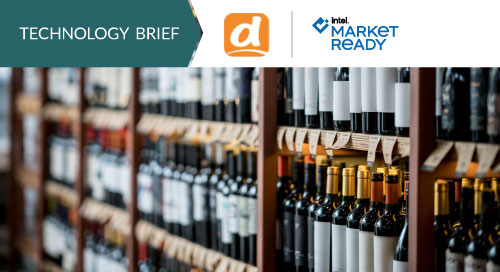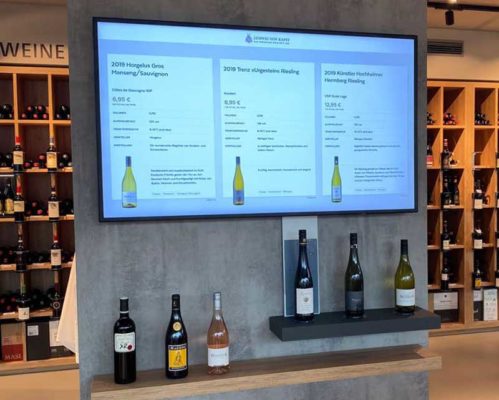Fill form to unlock content
Error - something went wrong!
Get the latest on IoT and network edge for retail.
You are following this topic.
Smart Retail Solutions Transform the Shopping Experience

It’s Friday night, and you’re invited to a friend’s house for dinner. You want to impress them with a nice bottle of wine, but there are hundreds of options. Imagine if you could walk into a wine store and be virtually transported to the vineyard where the bottle of Cabernet you’re contemplating was produced. You “meet” the vintner and discover that the varietal is a perfect accompaniment to the main course. Confidence in your selection soars, you purchase the bottle, and you’re on your way to a relaxing evening.
A wine chain in Germany is providing customers with this exact type of in-store experience. Founded in 1811, Rotkäppchen-Mumm is the largest producer of sparkling wine in Germany, with stores operating under the brand Ludwig von Kapff.
Its CEO had a clear objective: build the most modern wine store in Germany and do it with “invisible” technology that takes shoppers on a journey. The company created a unique interactive shopping experience by deploying the Digital Retail Media solution by digimago GmbH, a smart-signage solutions manufacturer.
“Wine store operators can give customers a small glass to taste, but what if they could bring the winery to them?” asks Andre Bartscher, CEO of digimago. “Wine is all about storytelling—stories about the winery and the makers. People who produce wine are often strong and interesting characters.”
Digital Signage Transports Wine Store Customers to the Vineyard
Customers who shop at Ludwig von Kapff will find digital signs running promotional content inside the store. Real-time digital signage drives the output, choosing the best products for the audience, time of day, and weather conditions. For example, a crisp Sauvignon Blanc might be promoted on a warm summer evening while sparkling wine can be featured during the holidays. Digital signage is also synced with POS data and retail analytics. If a product is low in inventory or out of stock, for example, it’s no longer advertised on the screen.
The solution uses near-field object recognition, RFID tags, and an invisible sensor surface to create an interactive experience. If a shopper wants more information about a wine, they can place the bottle near the screen. The passive promotional loop automatically shifts and displays information about the specific wine, such as price and taste notes. Shoppers can learn more about the winery and maker by tapping on the touchscreen. In addition, customers can place a second and third bottle near the screen to compare wines (Figure 1). And when the bottles are put back on the shelf, the screen automatically returns to the promotional content loop.

The technology is equipped with #AI-powered #PredictiveAnalytics, providing alerts when maintenance is required, and which pieces need to be replaced soon. Digimago GmbH via @insightdottech
digimago Digital Retail Media runs high-quality graphics that require high-performance computing power. The solution incorporates Intel® technology, including processors and the Intel® OpenVINO™ Toolkit.
“The interactive content is not video,” says Bartscher. “It’s really a real-time rendering, and Intel processing power makes it possible.”
Since it was deployed, the digimago solution has helped Ludwig von Kapff provide outstanding customer experiences while increasing sales. “Visitors describe the atmosphere as being engaging,” says Bartscher. “The technology helps start conversations between the shoppers and the staff. It provides a great ambiance and gets customers in the mood to taste and buy the wine.”
In addition to providing the hardware and software, digimago offers retailers peace of mind with monitoring services. If there is a technical or software problem, digimago will receive a notification. In some cases, the situation can be solved remotely, even before the customer knows there’s a problem. The technology is also equipped with AI-powered predictive analytics, providing alerts when maintenance is required, and which pieces need to be replaced soon.
Smart Technology Drives Omnichannel Retail
Rotkäppchen-Mumm’s use of smart retail solutions not only engages customers; it becomes the central part of its omnichannel strategy. To deliver omnichannel experiences, Bartscher recommends that retailers identify what type of content will be most relevant to its potential customer inside and outside of their stores.
“What information could influence them to buy your product?” he asks. “What experience could create a better time in your store for the customer? Think about the types of content and digital assets you already have. Then determine how you can create content for the different resolutions and screen formats.”
To make this possible, digimago’s rendering engine can generate animation and content in real time, using merchandise data as well as content from a company’s website and social media channels.
Bartscher predicts that as digital-signage technology evolves, it will become more closely integrated into retail analytics, continuing to put a strong focus on the customer.
“Studies have found that up to 70% of buying choices are done at the point of sale,” he says. “With digital signage, you can have a good channel to influence customers. Instead of having static content, you can have moving animated visuals that catch attention. When visitors stay longer, they will probably look at more products and buy more things.”
This article was edited by Georganne Benesch, Associate Editorial Director for insight.tech.